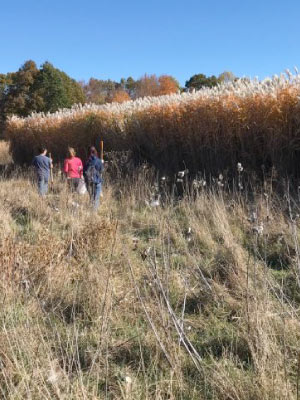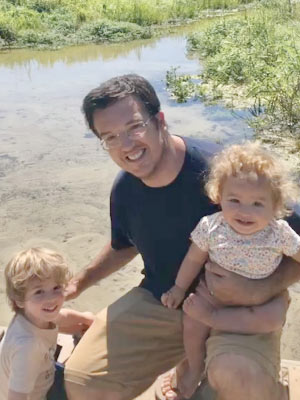
“Can I just start by saying, I mean, this is a dream job for me!” Zac Freedman’s excitement and inquisitive nature is palpable, even coming through a computer screen. Freedman, the O.N. Allen Professor of Soil Microbiology and principal investigator of the Freedman Lab on campus, has had his eye on the UW for quite some time. He grew up one block from Northwestern University’s football stadium; “They weren’t very good,” he says, so it was easy to sneak into games. “It was always a fun weekend when Wisconsin was in town.” After postdoctoral work at the University of Michigan and a few years as an assistant professor at West Virginia University, Freedman finally found his ticket to Madison.
Unfortunately, that ticket was issued in June 2020, so the campus that Freedman came into was far from typical. “To start a new lab during the pandemic was difficult,” he says, “specifically managing recruitment and different student needs during this time.” Global supply chain issues didn’t make it any easier — the lab is still receiving boxes of plastics that Freedman ordered last year. Their mailroom may be running behind, but the research is certainly looking to the future.
Most students and alumni have participated in a lab — but what all goes into starting and running one?
The most important aspect, I think, is coming up with ideas to write grants on to fund the lab. Then, recruiting students and staff to build up the lab structure, and then last to purchase equipment and supplies to enable students and staff to do the best possible research. With the general difficulties of the COVID era, all those three elements are made more difficult. But certainly, the student and staff recruitment, and acquisition of supplies has been very challenging.
What were the first things you wanted to dive into when you got here?
There were some ideas that came out in brainstorming sessions when I came to interview that I was intrigued by. For example, our department chair here, Alfred Hartemink, and soil physicist in our department, Jingyi Huang, they’re very much into predicting soil parameters based on soil sensing technology, so essentially scanning soil with an infrared gun, getting some spectral signals back and predicting various soil parameters. So we thought, “Wouldn’t it be cool to be able to use that technology to try and predict soil microbial functions, specifically functions that are used to predict the future fate of carbon?” … Just recently we wrote a grant based on that idea to the NSF and we won it, which was very exciting.
Is that how a lot of research projects come up? You think, “wouldn’t it be cool if,” and then you go figure it out?
For me, yes, but I wish that it weren’t! Some people, they’re able to summarize their research program in a nice, coherent sentence, and I can’t do that. I think I’m just naturally more of a generalist. In terms of building a new research project, I most importantly like to work with people that I enjoy spending time with with, and two, on ideas that I think are cool. One example of that is a project proposal that I wrote when I was still at West Virginia, but we found out that we won it after I started at the UW. It has nothing to do with soil at all. It’s about trying to understand generalizable mechanisms of community succession in different trophic levels that interact within carnivorous pitcher plants. The food web that’s contained within pitcher plants has been a model system in community ecology for more than 50 years. This project started from discussions with my best friend from graduate school who was a pitcher plant expert. From our time as graduate students, we’ve been talking about wouldn’t it be so cool if we can do this project that is now funded. He’s now a professor at the University of Florida, and when I got my professorship at West Virginia, we thought, “All right, we have to write this grant. Let’s do it!”
What are some of the outstanding “wouldn’t it be cool if’ questions you have?
In the sustainability area, I want to build a research avenue to better understand plant microbe interactions of alternative crops. I’ve been collaborating with Shelby Ellison in the Department of Horticulture here; she’s the state hemp specialist. There’s currently very little known about plant microbe interactions in hemp, and it just seems like such a clear growth area. The sustainability of hemp production is a ripe research area of the future. Then more in the forest side, I’ve been collaborating with some researchers out of the University of Michigan Biological Station, thinking about projects related to better understanding what happens when forests die. As a consequence of the state of the world right now, there’s a lot of forest death and loss of mature trees. Mature trees store tons of carbon, and they bring in lots of carbon in to soil from the atmosphere. What does enhanced forest death mean for the balance of carbon in our atmosphere?
What’s some cool research happening in your lab this semester?
My first PhD student in the lab, Brooke Propson, is doing work that is in continuation of my postdoc work … to better understand how forest systems will respond to changes in atmospheric nitrogen deposition — one consequence of the burning of fossil fuels. Forests, especially across this region, are limited by nitrogen. If you give them more nitrogen, that’s going to stimulate the forest productivity, so there’ll be more tree growth and ultimately more carbon stored in forest ecosystems. What my postdoc work found is that increased nitrogen also suppressed the decomposition of organic matter by the microbial community, which led to more carbon being stored in the forest soils due to this agent of climate change.

So, is that good or bad?
It’s ultimately a good thing, because if that carbon wasn’t accumulating in soil, it would be in the atmosphere. The Clean Air Act amendments in 1990 legislated controls on nitrogen pollution from industry, which is now reducing the rate of atmospheric nitrogen deposition — which is a good thing in theory. The only question is, what’s going to happen to all this extra carbon that’s built up in the forests from decades of elevated N deposition? What we hypothesize is going to happen with less nitrogen is that microbial decomposition is going to speed up … it may lead to a loss of all of that built up carbon in soil to the atmosphere and could be an unintended negative consequence of the Clean Air Act amendments.
You’re also working on a continuation of your research at West Virginia. What’s the focus of that?
It relates to sustainable land use. The point of this project is to find ways to repurpose formerly mined sites within the mid-Atlantic region, with a focus on the Appalachian region. What we’re trying to do is to identify best management practices to produce crops used for bio-based products like bioenergy and to manage the land to maximize plant-soil-microbe interactions that would ultimately capture carbon in soil as well as enhance soil quality. This is badly needed, because these are reclaimed mined lands, so as soils go, they’re just terrible and very carbon and nutrient poor. Due to these soils’ poor quality, we decided to grow especially robust bioenergy crops like Miscanthus × giganteus, switchgrass, and a hybrid willow species. These all have deep and robust rooting systems that we thought would be a way to bring nutrients from carbon from the air, through photosynthesis to the soil in the roots. Then as the roots die, they power microbial decomposition that can enhance stable soil carbon formation. The ultimate goal here is to use the plants, one, to generate energy, and two, to regenerate the land … so that eventually that land can be used to produce more profitable crops to enhance the value of the land.
So, you’re trying to sustainably regenerate the land by using only the soil, so that you can grow plants to create green energy?
Yes, that’s exactly right. It’s kind of a nice story, because these are all coal-impacted communities that are highly economically distressed. We’re trying to keep former energy lands in energy, but to move away from the coal-based energy and towards green energy to hopefully give a boost to those rural economies with few other opportunities for income.
What has felt like one or some of the most gratifying moments so far in your career?
Easily, without question, it’s my first PhD student finishing from West Virginia. He defended in the late spring last year. His academic background did not prepare him very well for the very unique challenges associated with a PhD program, and I didn’t know if he had what it took in the first year or two. But then at the end, he just caught fire. He was the runner up in the West Virginia University-wide three-minute thesis competition. He lost the championship by one point! He was strutting around that stage like he was giving a TED Talk or something, but compared to how he started, it was just amazing to see. Gratifying moments relevant to my life here is the quality of students. It’s amazing how great the students are, yet there’s that Midwestern humility. My interactions with students and brainstorming fresh ideas is easily the best part of my job.
You’re teaching Soil Science 323 this fall and Environmental Studies 101 in spring. What’s it like working with such different levels of students?
At the 100 level, it’s more about getting the students engaged in the university and excited about the environmental studies. That class is organized with a series of guest lecturers, so I’m more like a tour guide through the environmental studies at UW–Madison. Whereas the upper-level course is meant to enhance the depth of students’ understanding in a particular field. It’s pretty cool because all the students that take it (in theory) want to be there, so it makes the class a lot of fun. Then in teaching graduate students, that’s just one-on-one for the most part, just trying to get inside each other’s brains and try to better understand somebody — their strengths and areas for improvement — to try and bring out the best version of themselves. It’s just completely different, but a lot of fun.